Regional employment patterns in Scotland: statistics from the Annual Population Survey 2017
Summary publication of results from the Annual Population Survey 2017, presenting analysis on the labour market, education and training.
This document is part of a collection
Section 2: Type of Work
2.1 Type of employment
Full-time employment reached a record in 2017 with 1,910,600 people in full-time employment.
Since 2007, the levels of part-time and full-time employment for women have increased. For men, levels of part-time employment have increased, however men’s full-time employment level is lower now than in 2007.
Part-time working accounts for a slightly larger share of employment compared with 2007, increasing from one quarter in 2007 to around 27 per cent in 2017. Full-time employment has decreased slightly from three quarters of all employees in 2007 to 73 per cent in 2017.
Chart 9: Employment rate (16-64) by gender and full-time/part-time

Part-time employment accounts for 42.3 per cent of all women’s employment compared with 12.2 per cent of all men’s employment.
Part-time employment is also more common for those in employment aged 16-24 years (40.2 per cent) and for those aged 65 years and over where 61.9 per cent of all employment was part-time.
322,900 people in employment were self-employed in Scotland, close to the highest since the series began.
Chart 10: Proportion of people (16+) in employment who are self-employed by gender
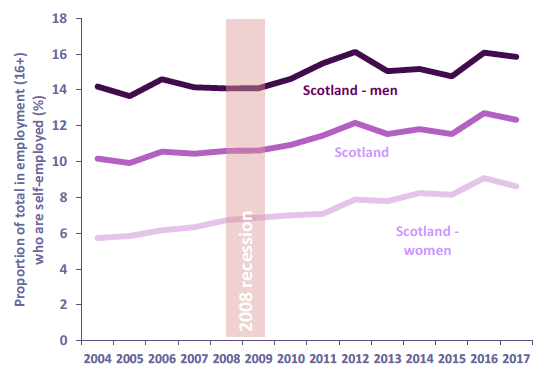
Self-employment accounts for 12.3 per cent of all employment in Scotland in 2017. Although this remains below the UK where 15.1 per cent of employment is from self-employment in 2017.
Women account for an increasing share of self-employment, 26.8 per cent in 2004 to 34.0 per cent in 2017. Women’s self-employment increased from 66,200 in 2004 to 109,600 in 2017.
Self-employed men increased from 181,000 in 2004 to 213,300 in 2017.
Chart 11: Employment (16+) by gender and work pattern
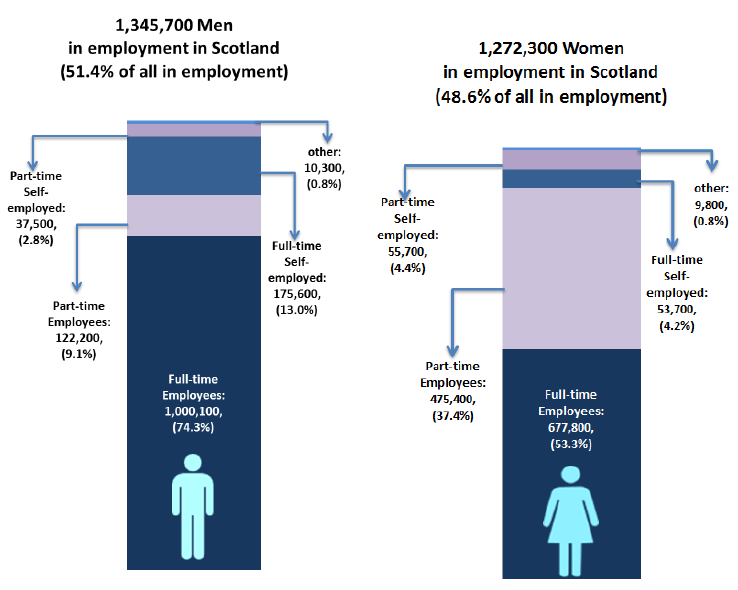
Note: a small number of respondents who were unable to report whether they were full-time or part-time have been excluded from chart 8.
2.2 Underemployment
What is underemployment? Underemployment refers to those who are in work but who would prefer to work more hours for the same rate of pay and provides a measure of underutilisation of labour. The APS only gathers information on hours based underemployment.
In 2017, 206,100 employees were underemployed in Scotland, the lowest level and rate since 2008.
Underemployment was highest amongst women (8.5 per cent) compared with men (7.5 per cent).
Underemployment is now significantly lower than the peak overall falling from 10.0 per cent in 2012 to 8.0 per cent. Men’s underemployment fell from 9.0 per cent in 2013 to 7.5 per cent in 2017 and women’s underemployment fell from 11.6 per cent in 2012 to 8.5 per cent in 2017.
By age, underemployment is highest amongst employees aged 16-24 years and at 16.1 per cent is over double the national average. In the period since 2012, underemployment has decreased across all age bands.
Underemployment rate (underemployment as a percentage of all employees) has consistently been highest amongst part-time men (24.0 per cent), followed by part-time women (14.2 per cent) and lowest amongst full-time women (4.4 per cent) and full-time men (5.3 per cent).
Chart 12: Underemployment Rate (16+) by age
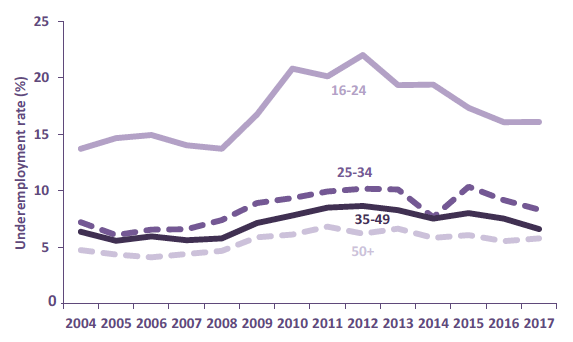
The largest decrease in underemployment over time, by gender and work pattern, was for part-time men where in 2013, 33.9 per cent reported underemployment. This has reduced to below a quarter (24.0 per cent) in 2017.
Chart 13: Underemployment Rate (16+) by working pattern and gender
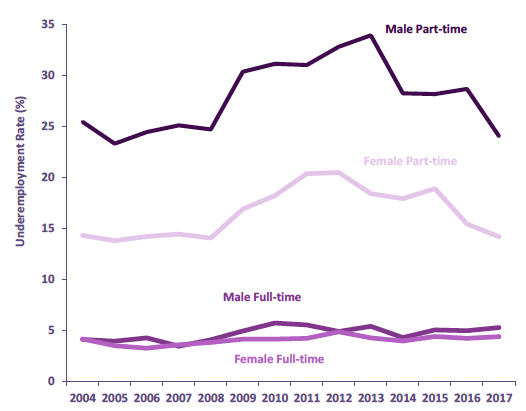
There is regional variation in the underemployment rate. (Data are not available for Na h-Eileanan Siar, Shetland or Orkney Islands).
The highest rates in 2017 were in Scottish Borders (13.2 per cent), Clackmannanshire (12.2 per cent) and North Ayrshire (11.8 per cent).
The lowest rates were in Dundee City (5.4 per cent), North Lanarkshire (5.4 per cent) and East Ayrshire (6.2 per cent).
In the last year, the rate of underemployment has decreased in 16 local authorities and increased in 13 local authorities.
The largest increases over the year were in Clackmannanshire increasing by 6.4 percentage points to 12.2 per cent*, Scottish Borders increasing by 3.7 percentage points to 13.2 per cent and East Renfrewshire, increasing by 3.1 percentage points to 10.2 per cent.
The largest decreases were in Dundee City, down 3.9 percentage points to 5.4 per cent.*, Midlothian down 3.2 percentage points to 7.0 per cent and Highland, down 3.0 percentage points to 8.3 per cent.
* statistically significant
2.3 Sector
Public Sector Employment accounts for a decreasing percentage of employment. Currently at its lowest in the series*, the public sector accounts for 25.3 per cent of all in employment and private sector is at a peak accounting for 74.7 per cent of all employment.
The local authorities with the highest public sector employment representation, outside of the Islands, were West Dunbartonshire (32.6 per cent), South Ayrshire (31.1 per cent) and East Renfrewshire (29.2 per cent).
* The series refers to Annual Population Survey Jan-Dec dataset in each year.
Chart 14: Changes in public and private sector employment (16+) 2004-2017, Scotland
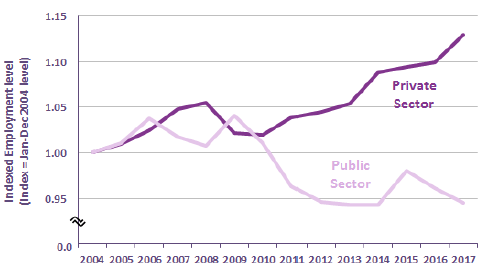
Note: Industry sector is self-reported on the Annual Population Survey and could be subject to some inaccuracy. The official source for estimating Public Sector Employment is the SG Quarterly Public Sector Employment Series.
In the last 10 years there have been substantial movements in the number employed by sector with 28,700 more women in the Public admin education and health and 12,800 less men. (Note this is not the same as the public sector)
Otherwise, larger changes were more men and women employed in banking, finance and insurance; (men up 49,700 and women up 33,800), and large decreases in manufacturing (men down 35,400 and women down 21,600) and a large decrease in construction for men (down 40,400).
Chart 15: Change in the number of people employed (16+) over the last 10 years by industry and gender, Scotland
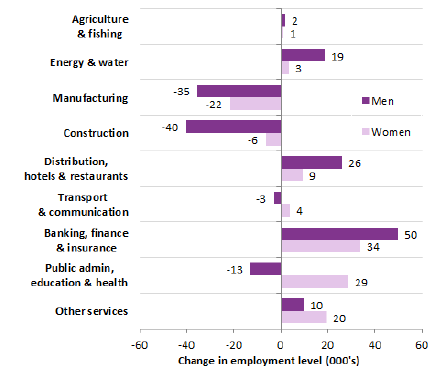
2.4 Gender Segregation
Gender segregation remains a persistent issue across several broad industry sectors and occupational groups in Scotland.
Chart 16: Proportion of all in employment (16+) by sector and occupation and gender, Scotland
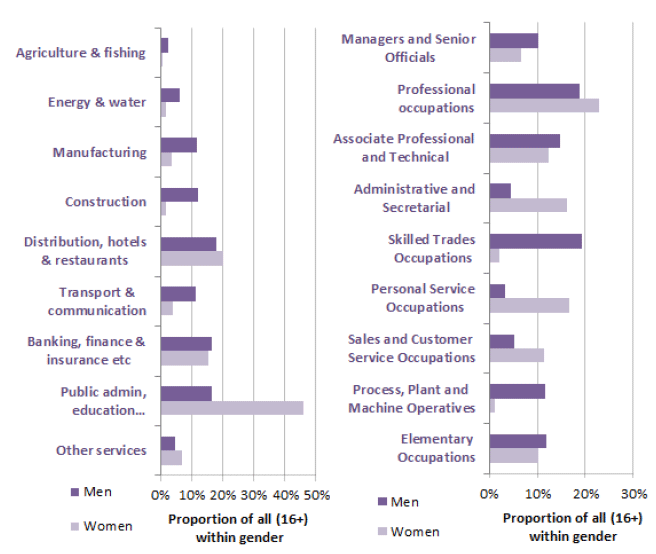
Although equality legislation has been in place for many years, gender segregation is still apparent in many industry sectors in Scotland.
Almost half of women in Scotland (45.8 per cent) work in the Public admin, education and health sector (Note this is not the same as the public Sector).
Over two-fifths (44.0 per cent) of men work in sectors that show high levels of gender segregation: Construction (12.1 per cent), Transport and communication (11.2 per cent), Manufacturing (11.8 per cent), Energy and water (6.3 per cent) and Agriculture and Fishing (2.6 per cent).
Gender segregation across the various occupational groups show a similar picture to that seen across industry sectors with specific occupational groups showing high levels of segregation.
44.3 per cent of women in Scotland were employed in occupations that are gender segregated towards women: Administrative and secretarial (16.2 per cent), Personal service (16.7 per cent) and Sales and customer service occupations (11.4 per cent).
31.1 per cent of men in Scotland were employed in occupations that exhibit high levels of gender segregation towards males: Skilled trades (19.4 per cent) and Process, plant and machine operatives (11.7 per cent).
2.5 Skills
Between 2004 and 2017, there has been a large increase in high skilled occupations (for example functional management e.g. in finance, marketing, public finance) and medium-high skill occupations (e.g. health associate professional occupation or nurse), compared with a decline in low skill (e.g. bar staff, cleaning) and medium low skill occupations (e.g. sales assistance, retail cashier).
Employment in higher skilled occupations increased by 29.0 per cent between 2004 and 2017, increasing from 536,800 to 692,700. Medium-high skilled occupations increased by 9.2 per cent from 657,000 to 717,700. These two categories account for 54.0 per cent of all jobs in 2017. Low skilled and Medium-low skilled occupations decreased over the same period, by 3.3 per cent and 0.6 per cent respectively.
Chart 17: Cumulative increase in occupation skills level of employment (16+) since 2004, Scotland
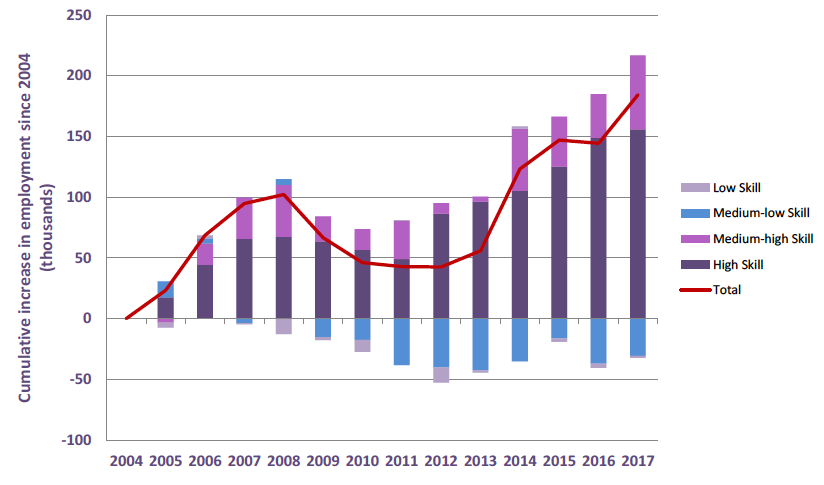
Contact
If you have any enquiries relating to Labour Market Statistics then please contact us at:
Email: LMStats@gov.scot
Telephone: 0131 244 6773
Fax: 0300 244 1060
Post:
Labour Market Statistics
OCEAES: Economic Strategy and Policy
Scottish Government
5th Floor
5 Atlantic Quay
150 Broomielaw
Glasgow
G2 8LU
We welcome any comments on both the format and content of the website, including any problems you may encounter.
You may also contact the Statistician Group Enquiries for general information.
There is a problem
Thanks for your feedback